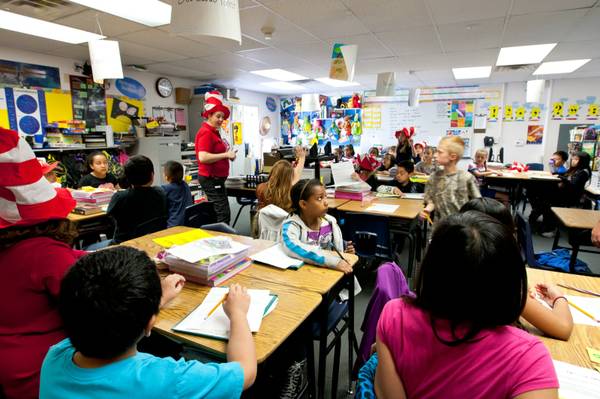Sun archives
Reducing class sizes in Southern Nevada to the national average would take $1.2 billion over four years, according to figures released by the Clark County School District.
But it will take more than the will of the School District or its teachers union to bring class sizes down. The Nevada Legislature will have to agree — and find a way to fund the effort.
Currently, class sizes in Clark County are among the largest in the nation, according to the district. In the wake of the recession, the School District raised its student-to-teacher ratios to balance its budget.
Although a 1989 plan to reduce class sizes has kept the average in first through third grades between 19 and 22 students, numbers in the other grades have ballooned with the growing population in Southern Nevada.
The average class in kindergarten has 26 students. By fourth and fifth grades, that number has risen to 34.
In middle and high school, the average class has 38 students. Some teachers in Las Vegas have reported classes in the 40s.
As the Legislature debates different tax proposals to fund class-size reduction, the School District and the local teachers union announced a four-year proposal to lower class sizes.
Here's how it breaks down:
Year 1: The School District would hire 835 teachers at a cost of $55.1 million. This would lower average class sizes by up to three students.
Year 2: The district would hire 1,100 teachers at a cost of $72.6 million. This would lower average class sizes by an additional two students.
Year 3: The district would hire 1,106 teachers at a cost of $73.2 million. This would lower average class sizes by an additional two students.
Year 4: The district would hire another 1,074 teachers at a cost of $70.8 million. This would lower average class sizes by an additional two students.
In total, the district and union's plan calls for hiring 4,115 new teachers, for a total of $271.7 million. The average teacher's salary with benefits is $66,000.
The additional teachers would be on top of an estimated 2,000 new educators being hired for next school year as a result of the School District's arbitration win against the Clark County Education Association in February. If all goes according to plan, the School District could have upward of 23,000 teachers by 2017.
That would lower average class sizes significantly in kindergarten, and fourth and fifth grades. Average class sizes in kindergarten would drop to 16 students. Fourth and fifth grades would see a drop to 26 students.
To accommodate the 6,000 new teachers and a growing student enrollment, the district also would have to build 37 new schools at a cost of $931.7 million. The average elementary school costs $25 million to construct.
In total, the new teachers and schools would cost the district $1.2 billion.
If this reduction plan seems like a pie-in-the-sky idea, it kind of is. It's contingent on a best-case funding scenario (really more of a miracle windfall) from Carson City, according to School District spokeswoman Amanda Fulkerson.
"It's more of a blueprint about how we would ideally bring class sizes down to national averages," Fulkerson said.
Critics of class-size reduction, such as Nevada Policy Research Institute, say the quality of a teacher trumps large class sizes. Research is mixed on the issue, but teachers overwhelmingly argue that smaller class sizes allow for individualized attention, which can translate to higher student achievement.
Gov. Brian Sandoval's proposed budget calls for additional money to expand full-day kindergarten and fund literacy programs for English-language learners. Reducing the class size doesn't seem to be his priority.
However, the education-minded Legislature may make reductions a priority for Nevada. Lawmakers are kicking around several tax proposals to fund K-12 education. If these new taxes come to pass, the additional revenue may go toward funding a reduction in class sizes.
For the better part of a year, the state teachers union has been pushing for a 2 percent margins tax on businesses earning more than a million dollars annually. Lawmakers didn't pass the petition initiative during this session, which means voters will have their say in 2014.
Democrats and Republicans are pushing competing tax plans. Democrats have yet to unveil their proposal, though an announcement is expected soon. Republicans are calling for a new tax on the mining industry.
Lawmakers also are debating ways to fund new school construction.
In November, Clark County voters overwhelmingly rejected a ballot initiative to raise the property tax to build four new schools and renovate 40 existing ones.
However, earlier in April, the School District unveiled a bill that would allow it to partner with a nonprofit corporation to build new schools. That nonprofit, acting as an agent of the district, would take a bond to market to secure financing.
With about a month left in the 2013 legislative session, the district and union are hopeful about seeing some new state money for education, and possible class-size reduction.
"We're optimistic about the conversation in Carson City," Fulkerson said. "Class sizes and education has been the driving force behind this legislative session."
"(This plan) is very feasible," said Ruben Murillo, outgoing Clark County teachers union president. "The best school reform would be the reduction of class sizes."



Join the Discussion:
Check this out for a full explanation of our conversion to the LiveFyre commenting system and instructions on how to sign up for an account.
Full comments policy